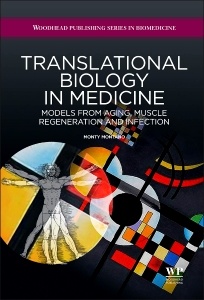Description
Translational Biology in Medicine
Woodhead Publishing Series in Biomedicine Series
Language: English
Subjects for Translational Biology in Medicine:
Translational Biology in Medicine
Publication date: 10-2018
228 p. · 15.5x23.2 cm · Paperback
Publication Abandoned
Publication date: 10-2018
228 p. · 15.5x23.2 cm · Paperback
Publication Abandoned
Translational Biology in Medicine
Publication date: 08-2014
228 p. · 15.5x23.2 cm · Hardback
Out of Print
Publication date: 08-2014
228 p. · 15.5x23.2 cm · Hardback
Out of Print
Description
/li>Contents
/li>Biography
/li>Comment
/li>
The recent emphasis in biomedical research on translational biology and personalized medicine is revolutionizing conceptual and experimental approaches to understanding and improving human health. Translational Biology in Medicine begins with an introduction to experimental model systems for disease, such as cell lines, primary cells, stem cells and animal models for disease, followed by a systematic description of genetic and genomic profiling and biomarker validation currently used in biomedical research. Examples of translation studies that have used these models and methods are presented, including studies in aging, tissue repair and chronic infection, each with an emphasis on how personalized medicine is transforming biomedicine. Bioethical considerations in translational study design and bioethical considerations in biomedical research are then covered, before concluding remarks, and a look towards the future of personalized medicine.
- Dedication
- List of figures
- Abbreviations
- About the author
- 1: Introduction and overview of chapter contents
- Abstract
- 2: Model systems
- Abstract
- 2.1 Introduction
- 2.2 Immortalized cell lines
- 2.3 Primary cells obtained from the host
- 2.4 Animal models
- 2.5 Stem cells: adult and induced pluripotent
- 3: Blood biomarkers: overview of existing serum test strategies for disease severity, risk for progression, therapeutic benchmark targets
- Abstract
- 3.1 Introduction
- 3.2 Early definition of biomarkers
- 3.3 Initial biomarker discovery
- 3.4 Translation into animal models
- 3.5 Translation into small human populations
- 3.6 Application to larger, more generalizable populations
- 3.7 Biomarker measurement considerations
- 4: Genetic and genomic profiling
- Abstract
- 4.1 Introduction
- 4.2 Theories of heritability of disease risk and severity
- 4.3 Gene expression signatures
- 4.4 Examples of gene expression signatures
- 5: Translational models, methods and concepts in studies of aging and longevity
- Abstract
- 5.1 Introduction
- 5.2 Theories of aging
- 5.3 The here and now: the world is aging
- 5.4 Telomere length/activity in aging
- 5.5 Stem cell aging
- 5.6 Aging and muscle tissue regeneration
- 5.7 Immune aging and immunosenescence
- 5.8 The insulin/IGF1 signaling axis in aging
- 5.9 Branched-chain amino acids (BCAA) and aging
- 5.10 Measurement of lifespan modulators
- 5.11 Factors influencing aging
- 6: Translational models, methods and concepts in studies of muscle tissue repair
- Abstract
- 6.1 Introduction
- 6.2 Muscle maintenance and regeneration
- 6.3 The role of satellite cell activity in aging and decline in muscle function
- 6.4 Muscle growth regulatory pathways
- 6.5 Sarcopenia and muscle maintenance
- 6.6 Functional limitations and therapeutic drug design
- 6.7 The TGFb1 axis
- 6.8 Inflammatory stress and muscle
- 6.9 Cachexia and muscle homeostasis
- 6.10 Anabolic effects of testosterone treatment
- 6.11 Use of high-throughput technologies with muscle to promote musculoskeletal growth
- 7: Translational models, methods and concepts in studies of acute and chronic infection
- Abstract
- 7.1 Introduction
- 7.2 From HIV origins to the modern era
- 7.3 HIV infection and aging
- 7.4 HIV-1 infection and transmission
- 7.5 Infection and innate host response
- 7.6 HIV and adaptive host response
- 7.7 HIV-1 comorbid conditions
- 7.8 HIV and drugs
- 7.9 Infection-associated inflammation and aging promote fibrosis
- 7.10 Viral eradication studies
- 8: Bioethical considerations and IRB challenges in translational biology study design and bioethical considerations in biomedical research
- Abstract
- 8.1 Institutional review boards
- 8.2 Institutional animal care and use committee (IACUC)
- 8.3 Big Data and the online privacy of health information
- 9: Concluding remarks and the future of personalized medicine
- Abstract
- 9.1 Introduction
- 9.2 Personalized medicine and aging
- 9.3 Personalized medicine and muscle maintenance
- 9.4 Personalized medicine and infectious diseases: HIV
- References
- Index
Dr Monty Montano is currently on the faculty at Harvard Medical School in the Department of Medicine. Dr Montano’s laboratory is broadly interested in HIV infection, muscle wasting, fibrosis, and aging bioscience. Dr Montano is also the founder and president of MyoSyntax, a life sciences company focused on identifying
personalized supplements that optimize gains in and reduce losses of muscle mass.
- Describes cellular and animal model systems used in translational research
- Discusses the use of blood, genetic and genomic biomarkers for disease
- Presents translational studies in aging, tissue repair and infectious disease biomedicine
© 2024 LAVOISIER S.A.S.




